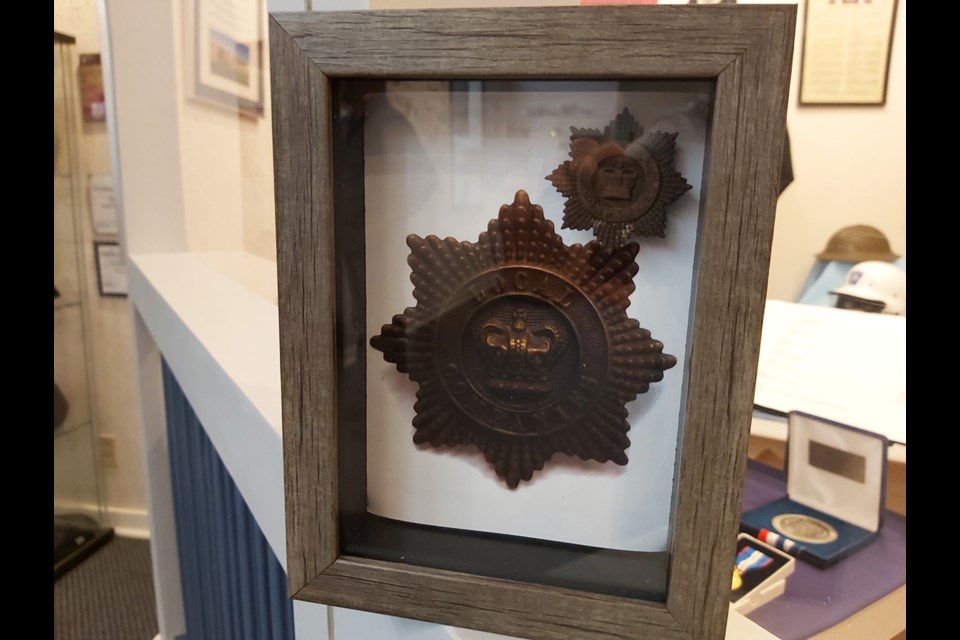It’s a great find for local history buffs, especially those interested in the Sault’s police and military history.
In July, Rob Gioia, a retired Sault Ste. Marie Police Service officer, historian and metal detector enthusiast, (or ‘detectorist’), discovered what has since been verified to be a badge - possibly a hat badge - belonging to a retired British Army officer sent to police what was known as the Village of Sault Ste. Marie in the 1850s pre-Confederation era.
Through his research, Gioia found there were approximately 1,000 such officers - known as members of the Enrolled Pensioner Force (EPF), commonly known as British Pensioner Guards - sent to train militia to keep the peace in Canada in the pre-Confederation era (other Pensioner Guards were sent to other colonies, such as Australia).
There were approximately 15 Pensioner Guards sent to the Sault and area, beginning in 1851.
Gioia discovered most of them went home to Britain by 1855 - the Pensioner Guards disbanded in 1859 - except for two notable exceptions.
Francis Hughes, a British Pensioner Guard who arrived in Sault Ste. Marie in the 1850s, was appointed Chief Constable for Sault Ste. Marie in 1856 (the community’s first police chief), serving in that role until 1868.
Another pensioner, Andrew Hynes, succeeded Hughes, serving as Chief Constable from 1868 to 1871.
It is believed Hughes Street and Hynes Street, in the Sault’s downtown core, were named in recognition of the two 19th century police chiefs.
“It's rather fitting, dare I say fate, that this relic was found by a retired Sault Ste. Marie Police Sergeant. It makes that historical connection so much more personal for me,” Gioia said.
It is possible either Hughes or Hynes may have worn the badge Gioia discovered.
Gioia discovered the badge while using his metal detector on private property in the city’s west end with the permission of the property owner, and after weeks of research needed for verification of the badge’s authenticity and history, donated it to the Sault Ste. Marie Museum’s Sault Police permanent exhibit Monday.
The small but historic item sits above and to the right of a photograph of it, showing its detail, contained in a framed box at the museum.
“I knew it was important. I knew it was special right off the bat. I knew it was Victorian. The more I looked into it I thought to myself this is more than finding a needle in a haystack, it was more like finding a needle in an entire hay field,” Gioia said.
“When I removed it from the ground I knew immediately it was something special. It’s a brass stamped star badge, bearing the crown and the designation ‘local companies.’ Its patina (a film that covers bronze or other metal objects over time) indicated substantial aging.”
Gioia had his research verified by Will Hollingshead, Sault Ste. Marie Museum executive director and chief curator, and Phil Miller, local military historian, with some input from the Canadian War Museum in Ottawa.
Photos of Hughes or Hynes have not yet been found, Hollingshead said.
“It is with great excitement that we are able to work with our partner Rob Gioia on this donation,” Hollingshead wrote in an email.
“I am personally thankful for all the hard work Rob, Phil Miller and those we have contacted have done to assist in this. We hope that this partnership is an ongoing one as we share and engage our community with their history," Hollingshead wrote.
"The discovery of this remarkable artifact not only moves the knowledge base about the local military establishment in the 19th century forward, but also confirms the written records of where local training took place. To say this is an unusual piece of military insignia, given the limited numbers of those who wore it, is to understate the reality. It will be something that local historical students will find something rarely seen in museums or even private collections," Miller stated.
The badge is not Gioia’s first major find or donation to the Sault Ste. Marie Museum.
In July 2020, Gioia donated an object - thought to be a spear tip from the ‘Old Copper Culture’ era - that he discovered while using his metal detector along the shores of the St. Marys River.
Old Copper Culture is a term used to describe ancient Indigenous North American societies which used copper for tools or weapons.
“It is estimated to be 3,000 to 5,000 years old,” Gioia told SooToday at the time, the relic authenticated by a Milwaukee Public Museum anthropologist.
“I’m pleased to make this, my third donation, of an historical artifact to the citizens of Sault Ste. Marie and the surrounding area by virtue of the museum. In this way I hope that these items garner enough interest so as to prevent our local history from fading into obscurity,” Gioia said.
